Disguise. The art of being invisible
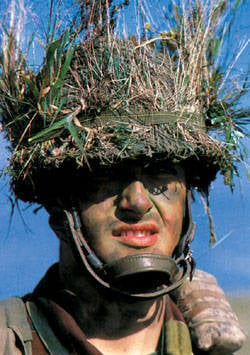 Wonderful stories Invisible hat can be found in fairy tales and legends of almost all the peoples of the world. Wearing such a hat, the heroes of fairy tales, invisible, penetrate anywhere and everywhere, easily overcoming all kinds of monsters.
Wonderful stories Invisible hat can be found in fairy tales and legends of almost all the peoples of the world. Wearing such a hat, the heroes of fairy tales, invisible, penetrate anywhere and everywhere, easily overcoming all kinds of monsters. The ancient dream of a stealth hat is still alive today. Invisibility is now thought of in order to better fight the enemy. Is it possible to become invisible and how? How to hide from the enemy's eyes?
The art of becoming invisible is widely used in military affairs and is called disguise. War is also a gigantic masquerade. On the battlefield, everything changes its appearance, color and size. The infantry dresses in the forest Tanks hiding under the roof of the house, the observation post is made up with a grave, the bunker is pretending to be a snowdrift, the person is a sheaf of unfinished rye, a stone or a stump. Movable becomes motionless, black - white, large - small.
Combat experience has shown that only an attentive eye of an experienced observer can detect a hidden enemy disguised on the ground, with barely noticeable signs. Fighting ground troops are conducted, as a rule, in areas of the area where the settlements are located, roads, forests, rivers, marshes. Some local objects can serve as shelters, facilitate the conduct of the battle, others, on the contrary, make it difficult. With skillful actions, the irregularities of the earth's surface and various local objects become reliable helpers of a warrior in battle. Proper use of them for locating a firing position, a place of observation, a camouflage allows divisions and individual fighters to strike at the enemy while hiding from his fire. It was not for nothing that during the years of the Great Patriotic War, experienced soldiers said: "Disguise is cunning and dexterity."
Disguise is an integral part of the combat activity of all branches of the military in any kind of combat, so the military trick is to skillfully hide the true state of affairs in oneself and mislead the enemy, giving the false to the real, forcing him to make the wrong, knowingly advantageous decision. A big role in this is played by the quickness and dexterity of the actions of the warriors.
When they want the enemy not to notice the movement of the unit from one area to another, the visibility of his stay is created at the old place, fires are burned, roads remain, and the rapid activity of people is simulated. During the battle, almost everything that even in the slightest degree can help the enemy determine the true situation is disguised: people, weapons and military equipment, facilities, traces of actions of troops, etc. The enemy is mislead so that he would take the lying soldier as bump a gun - for a bush. And despite the fact that the methods of disguise have long been known, everyone uses them.
Bait for the German sniper. Kalininsky front 1942 year.
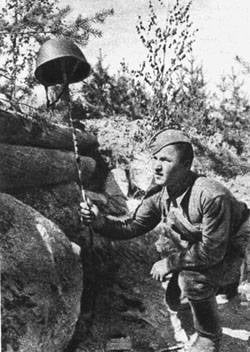 There are two main types of disguise: natural and artificial. Natural camouflage involves the adaptation to the terrain: the use of the masking properties of forests, groves, ravines, crops, settlements, lighting conditions — dark time, shadows from local objects, rain, fog, heavy snowfall, which limit visibility and reduce the possibility of enemy observation. Artificial camouflage is achieved by technical means and consists in the construction of artificial masks, mock-ups, the coloring of objects to the color of the surrounding terrain, the use of camouflage clothing, the production of smoke screens, the creation of anti-radar masks and noise masks. Special types of artificial camouflage are radio, light and sound masking.
There are two main types of disguise: natural and artificial. Natural camouflage involves the adaptation to the terrain: the use of the masking properties of forests, groves, ravines, crops, settlements, lighting conditions — dark time, shadows from local objects, rain, fog, heavy snowfall, which limit visibility and reduce the possibility of enemy observation. Artificial camouflage is achieved by technical means and consists in the construction of artificial masks, mock-ups, the coloring of objects to the color of the surrounding terrain, the use of camouflage clothing, the production of smoke screens, the creation of anti-radar masks and noise masks. Special types of artificial camouflage are radio, light and sound masking. Before you conceal, it is necessary to identify and eliminate various signs unmasking their troops. In fact, will the ravine hide even a small unit if there are visible clouds of smoke from bonfires, divorced by soldiers? Of course not. On the contrary, it will only attract the attention of the enemy. Also, no camouflage suits will not help cover the ski squad, if it leaves traces of movement in the snow.
Combat experience gives us numerous examples of how, thanks to the skillful disguise, the soldiers of different armies remained invisible and invulnerable.
Already in World War I, along with tanks, flamethrowers and aviation on the battlefields a powerful military tool appeared - invisibility.
A sea of paint — green, yellow, gray, brown — took the color of cannons, machine guns and soldiers' uniforms to match the color of grass, sand, and earth. Special factories produced amazing products: trees, stumps, grave crosses and swamp hummocks. They were very much like real ones, but they were made of steel. Crouching behind the armor of these masks, the invisible observers saw everything that was done by the enemy.
In 1916, during the First World War, fighting on the French front was mainly of a positional nature. Opponents, buried in the ground opposite each other, for months stood in one place and knew literally every peg and every pothole. The space between the trenches, the so-called neutral band, was studied with microscopic thoroughness. Each empty can thrown out of the trench was immediately subjected to fierce shelling. It seemed that there was nothing to think about in order to build a new observation post almost in front of the enemy, but that’s what the French invented.
In one place in the neutral zone, the soil arched with a hill. Both lines of trenches crossed the Paris road here. At the top of the hill, which gave a magnificent overview of the German positions, there was a stone pillar, and on it was a sign indicating the distance to Paris.
The French photographed this post and sent it to the factory. There, an exact copy of the column, hollow inside, with a hole for the observer, was cast from steel. They made both a sign and an inscription.
At night, the French scouts crawled into the neutral zone, dug a real pole, and put a steel copy in its place. An underground passage dug out of the trench to this original observation post. For more than a month, a French observer sat in a steel “stone” and, without interference, watched everything that was going on in enemy trenches. The Germans never guessed about this trick.
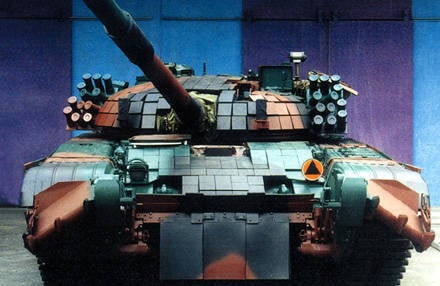
There are many methods of masking. It is based on three main principles: activity, believability, diversity.
MASK ACTIVITY
By activating camouflage, we seek to create in the enemy the wrong, desired idea of our forces and means, their placement, intentions and force the enemy to make wrong decisions. It is achieved by carefully concealing the real and showing the false.
The active disguise widely used by the Red Army during the Great Patriotic War. Numerous false objects were built, the transfer of troops from one region to another was simulated, false concentrations of units and subunits were shown, etc. On one of the fronts, our troops, using frozen lakes, organized false airfields completely imitating the lives of real ones. They were made from plywood mock-ups of aircraft, from cane - fuel depots. The enemy commanders, knowing about the impending offensive and finding a network of such airfields near the advanced positions, took them for true and brought down all the power of their air strikes and the power of artillery fire on them. After the enemy’s aviation and artillery raids, our soldiers set fire to previously prepared buckets of fuel oil and straw. The fascist pilots flew away, considering their task accomplished. This allowed Soviet aviation to concentrate without hindrance on real and carefully disguised airfields and from there to deliver devastating blows at the enemy.
The commanders of the subdivisions, both on the offensive and on the defensive, widely used the active disguise. In September 1943, units of the Red Army approached the Dnieper. One of the infantry battalions began to raft the river near the village of Korobovo. The Nazis lit the river. Finding rafts, fired at them. Then the battalion commander left one platoon of riflemen and several sappers in the old place and ordered them to demonstrate repeated attempts to force the river, and he transferred the main forces below the village and organized a new ferry there. The soldiers who remained at the old place put snags on rafts and pushed them away from the shore. The Nazis were concentrated fire on these rafts, wasting power and ammunition in vain. Meanwhile, the battalion safely crossed the Dnieper in another place where the enemy did not expect it.
Not less skillfully used active disguise and individual fighters. In the summer of 1944, during the battles to hold the bridgehead on the west bank of the Vistula River, artillery reconnaissance could not find the enemy’s mortar battery, which systematically bombarded our positions at night. Then Sergeant I. Yusupov decided to fire this battery during the day and thereby open its location. For this purpose, he built a false one at night in 200 m from his observation post. Two glass jars, respectively set, imitated the brilliance of the glasses of the optical instrument, and the moving helmet represented the observer. The helmet, which the sergeant, hidden in the side, raised, pulling the cord, was first fired by the Hitlerite sniper, and then the mortar gunner, finding the location of his battery. So active disguise - creating false trenches, leading edge, observation posts, positions of tanks and machine guns, airfields, maneuvers of manpower, wandering tools - disorienting the enemy, knocking him confused, forcing him to open fire, thereby finding his firing points.
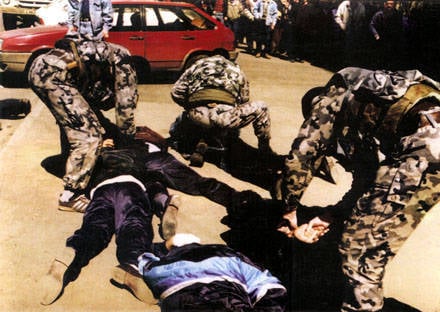
However, one should not underestimate the enemy, his ability to observe and shoot accurately. Therefore, any active camouflage action, every false construction, every false maneuver should resemble the real ones. Any fiction requires "revitalization" - movement, firing, - to make the enemy believe in everything that happens.
In this case, the advantages of masking can be negated if all necessary measures are not respected. In battle, the slightest mistake can be disastrous.
This is how the "performance" played by the Germans in the winter of 1942, in front of the village of Dolginevo, ended. They built the Nazis bunkers. And without binoculars one could see dark stripes of embrasures. From time to time behind the snow shaft, figures appeared in helmets and quickly disappeared in one of the bunches.
Our snipers hit the embrasures, fired at ran over soldiers. The distance is small - 300 meters. How can you not get there! And really the figures in helmets fell over the shaft. But the enemy did not stop the fire, and at certain intervals over the parapet again fascist helmets loomed. “It seemed strange to me,” the sniper Konstantin Borovsky told later. “What carelessness is this? Some will pack it, and in half an hour others will walk around at the same place. I decided to find out what it smells like.
At night, I got close to eighty meters. Closer the Nazis did not let. Lit a rocket, burn with might and main. I had to lie down. He buried himself in the snow and thought: “Since it’s so close, you have to look at what they did for a party here.” Start to dawn. The tapes of tracer bullets were completely pale, and I was still lying. Chilled by the order. I looked, behind the shaft again the figures in helmets. They look kind of strange and move something very smoothly. I looked more closely and understood everything. The soldiers, blithely walking under our fire, turned out to be just puppets. Crawling along the bottom of the trench the Nazis dragged them on long sticks. Hillocks with clearly visible embrasures were false bunkers. The fascists built real bunkers to the left along the highway. They were much lower, and the embrasures in them were carefully covered with white rags.
The Hitlerites played a comedy comedy in order to divert our attention. When we started to shoot at the dolls, the Nazis opened fire from real bunkers. Crawling, I returned to the company. We rolled out the anti-tank gun to an open position and began to strike with direct fire no longer on the scenery, but on the real bunkers. So failed fascist performance ".
We must not forget that in war the enemy is observing the terrain day after day. And if on a place where there was nothing before, any structure suddenly appears, it will naturally attract attention, and the lie may be revealed. Arranging false structures, you can not violate the original natural appearance of the area.
Judgment of masking
MASKING only then does not arouse suspicion of the enemy, if it is plausible, natural. Any artificial camouflage will only be difficult to recognize if, by its position, shape, size and color, it more closely matches the objects around it, that is, when it is plausible. An experienced warrior will always take advantage of the old, tried and tested ways of the art of believability that nature taught him. As in nature, the plausibility of disguise in military affairs is achieved by the fact that all masked objects are given an appearance that does not cause suspicion of naturalness. Everything must correspond to the surrounding area, not to make it alien, sharply different from the natural objects it contains. But even with the observance of this general rule, it is necessary to take into account the peculiarities of each particular locality, to exercise caution and prudence.
Thus, at the beginning of the Great Patriotic War, practically all of Moscow was painted with colorful stripes, squares and irregular-shaped spots appeared on the walls and roofs of houses and even on asphalt squares. In addition, in the same colorful camouflage were painted tanks, guns and cars. What is it for?
You can do a simple experience. Cover an ordinary white plate with black stains so that they fit to the edges. Now put the "camouflage" plate on the black table and step back a few steps. Carcass stains will merge with the table, and you can only see white pieces of irregular shape. The painted parts will fall out of the plate, as it were, and it will become unrecognizable. If you put a disguised plate on a white tablecloth, only black spots will be visible, and the whites will disappear.
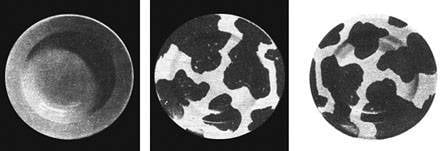
Sniper in green field uniform on a green lawn is invisible. But if he crawled on arable land or walked up to the house, he would immediately give himself away. Green silhouette on the black soil or on the background of a brick wall will be visible from afar. This is where the sniper saves the camouflage robe. With him you will not be lost anywhere. This is the same plate painted with mascara. Green spots merge with grass and leaves, brown with clay and pine trunks, gray with sand, with rocks, with concrete walls, black with black soil and charred beams, white with snow. In vain the enemy will strain his eyesight. He will see only the irregularly shaped spots that have merged in color with the background and will never guess that this is the sniper whom he so diligently sought.
However, at the beginning of the war, in the summer of 1941, there were still frequent instances when our troops used an ill-concealed disguise. In the battle of Novograd-Volynsky, some machine-gun crews took up firing positions in the sand, and disguised themselves as green cloaks. Naturally, the enemy easily found the machine-gunners on the green spots on the yellow sand, immediately fired at them and forced them to change firing positions. You can give another example of unsuccessful disguise. On a mown meadow, which was well studied by the enemy observers, there were four stacks of hay. It was to this sector of the front that a fresh Soviet tank unit arrived. Not carefully enough assessing the situation, the commander of a tank company ordered to mask all combat vehicles under the stacks of hay. The Germans, having discovered 8 new haystacks in the morning on the meadow, began firing at them, as a result of which the tankers suffered unjustified losses. Now, if only four tanks were disguised as haystacks — by the number of rifles — masking would be plausible and would not cause enemy fire.
The easiest of all is the likelihood of adapting to the terrain, using its masking properties, giving the disguised objects the shape, shape and color of objects that are present in the particular terrain. This is largely due to the skillful use of vegetation cover (grass, crops, reeds, moss, shrubs, tree branches).
Using vegetation cover, each warrior is able to make all kinds of improvised camouflage tools on his own, and by attaching branches, grass and straw to clothing and equipment, he can create such a camouflage suit that will merge with the surrounding background. To achieve credibility, military equipment and structures are masked by special camouflage nets into which branches, bunches of grass, hay, and straw are woven into the summer, depending on which one is more suited to the surrounding landscape, and in winter - a white fabric ribbon.
The warrior’s best friend in combat is the area around him. In an intelligent soldier disguise is always at hand. The sand lies - the sniper is buried in the sand, the snow becomes a snowdrift. In the forest, it is hidden by trees, stumps, branches, heaps of brushwood, in the swamps - reeds, sedge, in the field - grooves, staves, and uncut mowing. In the city, sniper expanse: here he will be rescued by a pile of bricks, sheets of roofing iron, crumbling plaster or a wrecked tank. Houses, basements, attics, walls and fences, manholes and factory pipes seem to be specially created in order to shelter him from the attentive eyes of the enemy. Even in the bare steppe, the warrior will find a good shelter - dunes, tumbleweed bushes, stones and rocks, half-covered with sand. Everywhere and always a sniper is surrounded by "friends" who hide him, and "traitors" who can betray him to the enemy. It is necessary to know the character of both those and others, and then the “invisible cap” will always be at hand.
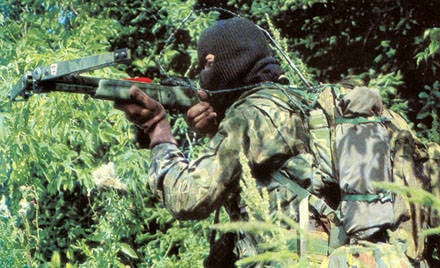
Thus, for observance of plausibility, first of all, it is necessary to properly use the masking properties of local objects and vegetation, as well as artificial means and to prevent the use of masking materials and objects that are absent in the area or not characteristic of it. Only with good skill and witness can you make yourself, your weapon and its firing position is invisible to the enemy. The effectiveness of disguise when performing the likelihood principle is greatly promoted by the diversity in its techniques and methods.
VARIOUS FORMS OF MASKING
If the most sophisticated masking techniques are repeated several times, they can easily be guessed by the enemy. The pattern in this case is not only unacceptable, but even dangerous. In 1942, the firing positions of the machine guns of one of our rifle subunits, which occupied defensive lines, were disguised as bumps and small tubercles. Such a disguise was successful. For a rather long period, the enemy could not detect them, since the terrain was full of bumps. But in the end, the Germans noticed that the fire was fired precisely from those places where there were separate mounds, and soon discovered a disguise system. Part of the Soviet gun emplacements was destroyed by enemy artillery and mortar fire. After short offensive battles, the same unit again in this sector of the front passed to defense. Forgetting that the enemy had revealed their reception, the warriors again began to mask the machine guns under the hummocks. Obtained in previous battles, the enemy observers immediately revealed the location of the firing positions of the Soviet machine guns, and the calculations suffered unnecessary losses.
Soviet sniper in camouflage overalls. It is noteworthy that the sniper rifle is intertwined with oak branches. 1943-1944 years
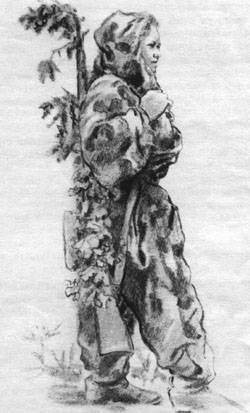 This example shows that masking constantly requires diversity, the use of new techniques every time, which are not yet familiar to the enemy and can give the greatest effect in specific conditions of the terrain. Diversity is precisely in order to avoid repeating the techniques and methods of masking a particular object or applying the same method to the same objects. In disguise, it is extremely necessary to display ingenuity, resourcefulness, even real creativity.
This example shows that masking constantly requires diversity, the use of new techniques every time, which are not yet familiar to the enemy and can give the greatest effect in specific conditions of the terrain. Diversity is precisely in order to avoid repeating the techniques and methods of masking a particular object or applying the same method to the same objects. In disguise, it is extremely necessary to display ingenuity, resourcefulness, even real creativity.A variety of techniques and ways to disguise helped win victories to entire units. In the summer of 1944 in Belarus, the Soviet rifle battalion pursued the retreating Germans. His task was to cut the enemy's escape routes. The terrain was impassable, marshy, and the battalion could not get around the Nazis, moving on the only good road. Then the battalion commander formed an assault detachment from a platoon of machine gunners, two pairs of snipers and ordered a forced march to go 40 km off-road, overtake the enemy, go to the river to the bridge and delay the departing enemy for several hours before the main forces of the battalion approached.
Having made a rapid throw in the marshy forests, the detachment, ten hours later, went to the indicated bridge and crossed it to the opposite bank. Having blown up the bridge behind them, the Red Army men defended themselves, carefully camouflaged at the edge of the forest. Soon the German transport column approached. Carts, cars, armored personnel carriers, artillery guns, several hundred people huddled around the blasted bridge. The squad opened fire on this cluster. The Nazis otlylyuli from the bridge. A shootout ensued. The enemy artillery battery entered the battle. However, she fired an innocent fire, because she did not know the location of our well-disguised fighters who had stopped firing for the time being. A group of enemy sappers headed by an officer approached the bridge and began to repair it. Then the snipers joined the battle. The officer was hit by the first bullet, enemy sappers began to fall behind him. Repair the bridge and the enemy did not succeed.
Hitlerite artillerymen again opened hurricane fire, but even he did not bring the detachment any harm, since this time the fire was not aimed. The enemy started to use all the means at his disposal, up to six-barrel mortars, shooting at the squares already. The forest caught fire. Our squad departed to the side and, observing all the rules of disguise, opened slander fire, not allowing adversary sappers to the bridge.
German infantrymen tried to wade through, but well-aimed shots of Soviet machine gunners and snipers hit them one by one. Having lost several dozen people killed, the Nazis refused to cross the river. The artillery of the enemy entered the battle again. When the shells began to go quite close, a detachment of Soviet soldiers through the forest moved to the other side of the bridge and took new positions here, hiding in the bushes. And again, accurate fire fell on the Nazis. Often changing the place, carefully masking and firing accurate fire, a platoon of Soviet machine gunners and four snipers withstood the nearly five-hour battle with the superior forces of the enemy until the approach of his battalion.
So courage, audacity, maneuver with careful observance of masking and its most important principle - diversity (the fighters were disguised sometimes on the edge of the forest, now in a small depth from it, then in the bush) - helped a small group defeat a numerically superior opponent. This fight once again confirmed that in disguise it is necessary to constantly display ingenuity and independent creativity in order to achieve its diversity. Of great importance is the knowledge of unmasking signs. We already spoke about them in the article “Fight with eyes: the one who sees wins” (“Little Brother”, 2006, No. 3). But there it was about the signs by which the observer can detect the enemy. Now it is necessary to consider them from the point of view of a disguised warrior.
DEMASING SIGNS
The effectiveness of disguise depends primarily on how skillfully the unmasking objects and signs are hidden from the observation of the enemy. The signs by which the enemy can detect fighters, structures and military equipment include color, shape, shadow, as well as movement, traces, sounds. The unmasking effect of these signs is enhanced or weakened, depending on the natural conditions in which military operations take place; the nature of the surrounding area; time of year; weather conditions; lighting and from the general combat situation. Overcast, inclement weather - rain, fog, snowfall - hide them, as the terrain takes on a dull look. Clear sunny weather, on the contrary, enhances some of them. Sharply visible outlines of objects; metal parts of weapons, equipment, glass optical devices, smooth surfaces give reflections on the sun.
Items vary in color, which affects their visibility. Equally colored, they seem to merge with each other, variously colored are very different. Of great importance is the nature of the surface. The same color may look different depending on whether the subject has a matt-faded or glossy-shiny surface. A flat glossy surface that gives a gleam of light rays is easily detected by the observer. Therefore, it is not by chance that military clothing and military equipment are painted in a soft khaki color, which is most often found in nature, helping to merge with the surrounding terrain.
Crossing of Russian soldiers disguised with improvised means across the river
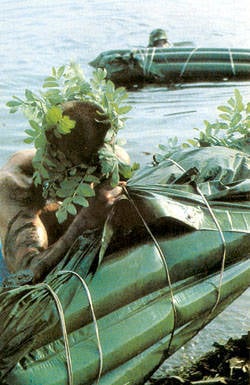 However, there is still no such mask, which would always and everywhere be able to hide a fighter. How can a soldier unmask a color? We can give an example: a trench has been dug up in full profile for shooting while standing on a grassy meadow, and the ground thrown around it is not covered by turf. A black patch of earth on a green grass background will stand out sharply and will give the enemy a trench site. A man in a gray overcoat in the snow is visible from afar, and invisible in the snow in a white robe the enemy will see a kilometer among the bright greenery; the shelter that perfectly hid the arrow in the morning could be his grave at noon. Faded leaves among green vegetation can indicate that someone or something is hiding behind them.
However, there is still no such mask, which would always and everywhere be able to hide a fighter. How can a soldier unmask a color? We can give an example: a trench has been dug up in full profile for shooting while standing on a grassy meadow, and the ground thrown around it is not covered by turf. A black patch of earth on a green grass background will stand out sharply and will give the enemy a trench site. A man in a gray overcoat in the snow is visible from afar, and invisible in the snow in a white robe the enemy will see a kilometer among the bright greenery; the shelter that perfectly hid the arrow in the morning could be his grave at noon. Faded leaves among green vegetation can indicate that someone or something is hiding behind them. The shape of objects and structures created by man also unmasks them, because it has clear contours. In nature, on the contrary, soft, indefinite prevail. If you look closely at the bushes, treetops, stones, bumps, rocks, you will not be able to find even a number of two completely identical outlines. Each of them has only its own silhouette, but not sharply different from the other. At the same time, people, military equipment and weapons are distinguished by their characteristic form, underlined by the shadow, color and brilliance of metal falling from them. Therefore, any camouflage clothing (except winter), military equipment and weapons camouflage spots that do not have the correct geometric shape; and all defenses are given outlines similar to local objects.
The most dangerous "traitor" on the battlefield is shine. Binoculars or telescopic glasses may shine in the sun; bayonet; flask; aluminum pot. Even a steel helmet, painted in a protective color, gives a reflection of the sun. The observer knows this well. A little bit of a sunny hare played somewhere, he will already be wary of looking for the reason.
Mountain Bundeswehr arrows in winter camouflage uniform
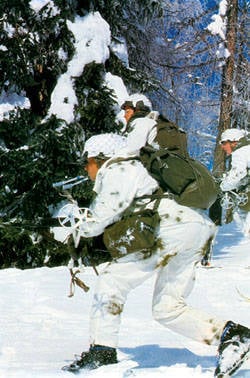 The famous Soviet sniper Mikhail Malov was once asked which, in his opinion, the most dangerous unmasking attribute. “Glitter!” The sniper answered without thinking. “I recently pulled off a button on my tunic. I sewed on copper unpainted and forgot about it. I should have removed the machine gun. And our company stood in a moss swamp. I told myself everywhere bunches of moss, a helmet with clay I smeared it and stuck the moss too, and my face was stained with grass: there is such a juicy one, I don’t remember what they say, only touch it - all hands are green. I put on my conscience. Between the hummocks and the wild rose, I crawled over to the Germans, I looked out. ! "- a bullet," chvak! "- the second. This shoulder has scratched. I noticed - I was going back. Well, the funnel was, plopped into it. I get upset and think: "What is my fault?" Then I saw a button. It was bright, damn, it glowed with heat - June, the sun. ".
The famous Soviet sniper Mikhail Malov was once asked which, in his opinion, the most dangerous unmasking attribute. “Glitter!” The sniper answered without thinking. “I recently pulled off a button on my tunic. I sewed on copper unpainted and forgot about it. I should have removed the machine gun. And our company stood in a moss swamp. I told myself everywhere bunches of moss, a helmet with clay I smeared it and stuck the moss too, and my face was stained with grass: there is such a juicy one, I don’t remember what they say, only touch it - all hands are green. I put on my conscience. Between the hummocks and the wild rose, I crawled over to the Germans, I looked out. ! "- a bullet," chvak! "- the second. This shoulder has scratched. I noticed - I was going back. Well, the funnel was, plopped into it. I get upset and think: "What is my fault?" Then I saw a button. It was bright, damn, it glowed with heat - June, the sun. ". This kind of "traitors" is cautious about every soldier with combat experience. Participating in hostilities, he carefully insures himself against brilliance. On a steel helmet puts on a protective cover or smears it with dirt, and if snow falls, she sheathes a white cloth. On a sunny day, the metal parts of the automat "powder": first it smears with gun oil on top and sprinkles with oil on sand or dust. In winter, he wraps the machine with a white bandage.
One of the most characteristic signs of unmasking is movement. While the disguised fighter is still, it is difficult to notice. But as soon as he begins to move, it is easy to detect. Therefore, a warrior on the battlefield must be especially attentive to his movements. Movement attracts the eye of the opponent’s observer, like a steel pin magnet. The highest grass, the thickest branches will not hide the sniper, if he moves inadvertently. Movement should be secretive, while abrupt or quick movements should be avoided, preferably all movements should be performed at night or in conditions of poor visibility. If you need to move on the terrain viewed by the enemy, then you need to make maximum use of all kinds of shelter, unevenness and folds of the relief, as well as vegetation, which will avoid the detection of enemy ground or aerial reconnaissance. Earth elements, such as hills or ramparts, absorb a significant portion of infrared energy and therefore can hide a soldier from being detected with infrared night vision devices. Moving in thick reeds, grass, crops, they are carefully pushed apart with their hands, and after passing, they slowly lower them into their place in order not to give themselves away. In the open space they try to move, having an object or some background behind them, if possible in the same color. When there is a suspicion that the enemy is watching you, it is better to remain motionless. If a unit is moving, it should be divided into small, mobile groups that should move in stages from one natural shelter to another, trying to avoid the appearance of their silhouettes against the sky or a contrasting background.
However, not only the movement itself, but its traces can serve as a unmasking sign. Traces of tracks and wheels left on the snow or grass of the footpath, even such trifles as traces of dew, trodden in the meadow by patrols advanced before dawn, will help the enemy to reveal the location and plans of the units. The sounds of troop activity are sharply unmasked - shots, noise of motors, crawling of tracks, strikes on the ground with shovels, conversation, cough, ringing of metal parts of weapons, etc. They give out, like light, at night and during periods of calm of the battle. In the years of the Great Patriotic War, there were more than once cases when the unstripped soldiers were outraged that they were forbidden to make fires, even when they were in the rear area. Due to inexperience, the fighters did not know that the glow of the fire was clearly visible at night from a distance of 8 km.
Finnish soldier in winter camouflage uniform
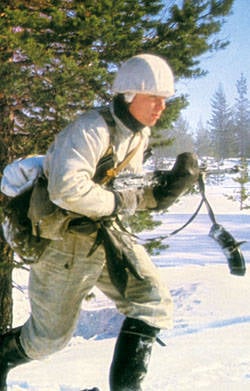 In addition, on a sunny day, another unmasking attribute is added - a shadow. The subject is better seen when it is brightly lit and casts a shadow, and the background on which it is projected is in color with it. For example, the sniper sneaks behind the wall, the sun shines in his back. I did not have time to reach the corner, but the enemy is already at the ready, waiting for him: through the dense brickwork no eyes could penetrate. Who could give a sniper? His own shadow. On a moonlit night in the snow, it is imprinted with a blue silhouette, a dark ripple will tremble on the water and, as if cut out of black paper, will lie on the sand in the hot afternoon. However, an experienced sniper knows the right way to get rid of this obsessive companion. Once he hides in another's shadow, his own disappears without a trace. Shadows of trees, houses, fences, hills will not only destroy their own shadow, but also hide the fighter.
In addition, on a sunny day, another unmasking attribute is added - a shadow. The subject is better seen when it is brightly lit and casts a shadow, and the background on which it is projected is in color with it. For example, the sniper sneaks behind the wall, the sun shines in his back. I did not have time to reach the corner, but the enemy is already at the ready, waiting for him: through the dense brickwork no eyes could penetrate. Who could give a sniper? His own shadow. On a moonlit night in the snow, it is imprinted with a blue silhouette, a dark ripple will tremble on the water and, as if cut out of black paper, will lie on the sand in the hot afternoon. However, an experienced sniper knows the right way to get rid of this obsessive companion. Once he hides in another's shadow, his own disappears without a trace. Shadows of trees, houses, fences, hills will not only destroy their own shadow, but also hide the fighter. Every soldier, especially a sniper, must always be on the alert. It can give a branch, swinging in calm weather; in winter, in severe frost - steam from breathing; produce faded leaves when everything is green around; gives a flash shot; careless step; fallen wood cracked under foot. It is difficult to list all the unmasking signs. The list will be huge and still incomplete.
Therefore, the basis of disguise - the elimination of unmasking signs. They need to know by heart. Only by a good idea of what the masked object looks like from the side and how it is unmasked can one correctly determine what needs to be hidden in it and what to modify. For this there are methods and means of masking, which are divided into two large groups: natural and technical.
Information